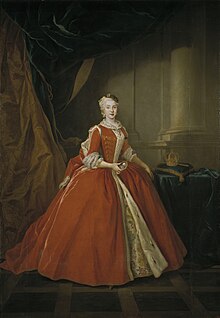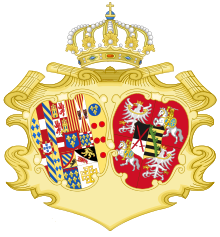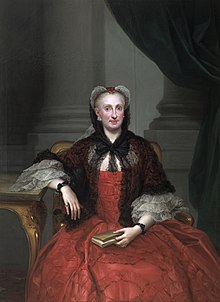Maria Amalia of Saxony (1724–1760)
Maria Amalia of Saxony (Spanish: María Amalia de Sajonia ) (born November 24, 1724 in Dresden , † September 27, 1760 in Madrid ) was a royal princess of Poland and electoral princess of Saxony. As the wife of Charles III. she was Queen of Naples and Sicily from 1738 to 1759 and Queen of Spain from 1759 until her death in 1760 .
Life
Childhood and youth in Dresden
Maria Amalia Christina Franziska Xaviera Flora Walburga was the eldest daughter of Elector Friedrich August II. Of Saxony , King of Poland, and Maria Josepha of Austria , eldest daughter of Emperor Joseph I , was born. It was named after her aunt Maria Amalia of Austria (1701–1756) , who became Electress of Bavaria through marriage. Maria Amalia grew up at the Dresden court and was taught foreign languages, mathematics, foreign cultures as well as theater and dancing. Like all of her siblings, she learned the strict etiquette that her mother gave them. Maria Josepha also took her children with her on the hunt, which she shared with many of her children as a passion.
Marriage plans
At first, Maria Amalia was not considered an interesting marriage match.
Charles IV of Naples and Sicily , later King Charles III. of Spain , son of King Philip V de Borbón and his wife Elisabeth Farnese , was initially engaged to Louise Diane d'Orléans , a French princess, at an early age . Later, the Austrian heiress Maria Theresa was discussed - this marriage project did not materialize either because Sweden and Denmark protested against the engagement. Only now did Maria Amalia come into play and was proposed as a new candidate for marriage. Although she didn't see the engagement and subsequent marriage as particularly beneficial, she agreed.
Marriage to Karl
In 1737 she was engaged to Carlos. The marriage was a project by Elisabetta Farnese . In December 1737 a papal dispensation was granted.
When she married Karl, Maria Amalia was 13 years old. The marriage took place on May 8, 1738 in Pillnitz near Dresden as a marriage ceremony per procurationem . The actual wedding was celebrated in Portella on July 6th of the same year.
Queen of Naples and Sicily
Although it was an arranged marriage, the couple were very close. According to the mother-in-law's reports, Carlos was very surprised and impressed by Maria Amalia's confident demeanor. She was described as a beautiful and skilled rider and accompanied Karl on his hunts. As Queen, she exerted great influence in politics and took an active part in state affairs. So she ended the careers of some politicians she didn't like, such as Manuel de Benavides y Aragón, Count of Santesteban; José Joaquín de Montealegre, Marchese di Salas; and Giovanni Fogliani Sforza d'Aragona, Marchese di Pellegrino. Maria Amalia did not try to hide her power in the small kingdom.
After the birth of her son Felipe, she received a place on the State Council. Like her successor Maria Karolina of Austria , she was against the influence of Spain on Naples and Sicily. In 1742 she convinced her husband, against Spain's will, to remain neutral for the time being during the War of the Austrian Succession, as there was a risk that the small empire would be bombed by the British, Mediterranean-ruling navy. In 1744, however, she was forced to give her consent to the declaration of war. It then favored Great Britain over France and Austria. Maria Amalia became a topic of conversation because of her favorites who influenced her politics, such as Anna Francesca Pinelli and Zenobia Revertera. In 1754 she supported Bernardo Tanucci's career as foreign minister.
Maria Amalia played an important role in the construction of the Palace of Caserta , for which she laid the foundation stone. However, she left Naples before completion, so she never lived in the palace.
Queen of Spain
In 1759 her husband inherited the Spanish throne and Maria Amalia became Queen of Spain. However, the following year she died of tuberculosis at the age of 35 in Buen Retiro near Madrid and was buried in the pantheon of the kings of the El Escorial monastery .
progeny
The eldest son Felipe Antonio suffered from brain damage that made him incapable of governance and reproduction, and died eleven years before his father, Charles III. Therefore, Felipe's younger brother Charles IV succeeded his father on the throne.
Maria Amalia and Karl had the following 13 children in the first 19 years of their marriage:
- María Isabel (1740–1742)
- María Josefa (* / † 1742)
- María Isabel (1743–1749)
- Maria Josefa (1744–1801)
- Maria Ludovica (1745–1792) ⚭ 1765 Emperor Leopold II , Emperor of the Holy Roman Empire of the German Nation
- Felipe Antonio (1747–1777), Duke of Calabria
- Charles IV (1748–1819), King of Spain ⚭ 1765 Maria Luise von Bourbon-Parma (1751–1819)
- María Teresa (1749-1750)
- Ferdinand I (1751–1825), King of the Two Sicilies ⚭ 1768 Maria Karolina of Austria (1752–1814)
- Gabriel Antonio (1752–1788) ⚭ Maria Anna of Portugal (1768–1788)
- María Ana (1754–1755)
- Antonio Pascal (1755–1817) ⚭ Maria Amalia de Borbón (1779–1798)
- Francisco Javier (1757–1771)
ancestors
literature
- Mirella Mafrici: MARIA AMALIA di Sassonia, regina di Napoli e Sicilia, poi di Spagna. In: Mario Caravale (ed.): Dizionario Biografico degli Italiani (DBI). Volume 70: Marcora – Marsilio. Istituto della Enciclopedia Italiana, Rome 2007.
- María de los Ángeles Pérez Samper: María Amalia de Sajonia , in: Diccionario biográfico español , Madrid 2009–2013, online version
Web links
| Predecessors | Office | Successors |
|---|---|---|
| Maria Barbara de Bragança |
Queen of Spain 1759–1760 |
Maria Luise of Bourbon-Parma |
| Elisabeth Christine of Braunschweig-Wolfenbüttel |
Queen of Naples and Sicily 1738–1759 |
Maria Karolina of Austria |
| personal data | |
|---|---|
| SURNAME | Maria Amalia of Saxony |
| ALTERNATIVE NAMES | Saxony, Maria Amalia Christina Franziska Xaveria Flora Walburga; Sajonia, María Amalia de |
| BRIEF DESCRIPTION | Princess of Saxony |
| DATE OF BIRTH | November 24, 1724 |
| PLACE OF BIRTH | Dresden |
| DATE OF DEATH | September 27, 1760 |
| Place of death | Madrid |





